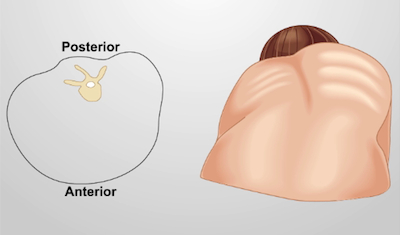Exame Respiratório I: Inspeção e Palpação
Visão Geral
Fonte: Suneel Dhand, MD, Médico Assistente, Medicina Interna, Beth Israel Deaconess Medical Center
Distúrbios do sistema respiratório com principal queixa de falta de ar estão entre os motivos mais comuns tanto para avaliação ambulatorial quanto internação. A pista visível mais óbvia para um problema respiratório será se o paciente está apresentando algum sinal de dificuldade respiratória, como taxa respiratória rápida e/ou cianose. Em uma situação clínica, isso sempre exigirá atenção emergente e oxigenoterapia.
Ao contrário da patologia em outros sistemas corporais, muitas doenças pulmonares, incluindo doença pulmonar obstrutiva crônica (DPOC), asma e pneumonia, podem ser diagnosticadas apenas por exame clínico cuidadoso. Isso começa com uma inspeção abrangente e palpação. Tenha em mente que em situações não emergenciais o histórico completo do paciente já terá sido tomado, ganhando uma visão importante sobre os históricos de exposição (por exemplo, tabagismo), o que poderia dar origem a doenças pulmonares específicas. Esse histórico pode então confirmar os achados físicos à medida que o exame é realizado.
Procedimento
1. Preparação para o exame
- Antes de examinar o paciente, lave bem as mãos com água e sabão ou limpe-as com lavagem antibacteriana.
- Explique ao paciente que você vai fazer um exame pulmonar.
2. Posicionamento do paciente
- Certifique-se de que o paciente está despido até a cintura (fêmeas mantendo a roupa íntima e expondo cada hemithorax um de cada vez).
- Posicione o paciente na mesa de exame em um ângulo de 30 a 45 graus e aproxime-se do paciente do l
Aplicação e Resumo
Procure em primeiro lugar qualquer sinal de problema respiratório em um paciente e padrão respiratório único. Doenças pulmonares graves subjacentes muitas vezes serão aparentes de simplesmente olhar para os pacientes. Condições como DPOC e enfisema podem se revelar na aparência do paciente e no habito corporal. Esses pacientes podem ser classificados livremente como "puffers rosa" ou "inchaços azuis". "Puffers cor-de-rosa" geralmente são finos e têm enfisema. Eles têm um peit...
Pular para...
Vídeos desta coleção:

Now Playing
Exame Respiratório I: Inspeção e Palpação
Physical Examinations I
157.0K Visualizações

Abordagem Geral para o Exame Físico
Physical Examinations I
116.3K Visualizações

Observação e Inspeção
Physical Examinations I
93.7K Visualizações

Palpação
Physical Examinations I
83.2K Visualizações

Percussão
Physical Examinations I
100.3K Visualizações

Auscultação
Physical Examinations I
60.9K Visualizações

Ajuste adequado da vestimenta do paciente durante o exame físico
Physical Examinations I
83.3K Visualizações

Aferição da pressão arterial
Physical Examinations I
107.7K Visualizações

Medição de Sinais Vitais
Physical Examinations I
114.2K Visualizações

Exame Respiratório II: Percussão e Auscultação
Physical Examinations I
212.5K Visualizações

Exame Cardíaco I: Inspeção e Palpação
Physical Examinations I
176.2K Visualizações

Exame Cardíaco II: Auscultação
Physical Examinations I
139.6K Visualizações

Exame Cardíaco III: Sons cardíacos anormais
Physical Examinations I
91.6K Visualizações

Exame Vascular Periférico
Physical Examinations I
68.1K Visualizações

Exame Vascular Periférico Usando Doppler de Onda Contínua
Physical Examinations I
38.5K Visualizações
Copyright © 2025 MyJoVE Corporation. Todos os direitos reservados




